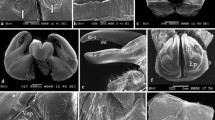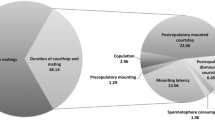Abstract
The stridulation of the giant pill-millipede genus Sphaerotherium from South Africa, one of only three groups of millipedes that produce sounds, was studied. One hundred one stridulation series of a total of nine different species (Sphaerotherium dorsaloide, Sphaerotherium hanstroemi, Sphaerotherium mahaium, Sphaerotherium similare, Sphaerotherium punctulatum, Sphaerotherium convexitarsum, Sphaerotherium dorsale, Sphaerotherium rotundatum, and Sphaerotherium perbrincki) were analyzed. Stridulation sounds are produced only with a special field of ribs on the posterior surface of the posterior telopod, which is actively moved over a field of sclerotized nubs on the inner margin of the anal shield. The Sphaerotherium male usually stridulates only when in contact with a female to initiate mating. This seems to prevent the female from volvating into a ball or stimulate the female to uncoil when already rolled in. The sound analyzes revealed a broad frequency spectrum in all stridulation sounds produced, without obvious differences in frequency distribution among species. However, the temporal pattern of the stridulation varies greatly between species and seems to be species-specific, arguing for a species recognition function of the stridulation during courtship behavior. A single species (S. punctulatum) was found to stridulate during mating while three species also show postcopulatory stridulation. Apparently, pill-millipedes are not capable of acoustic perception, as no hearing organs are known, indicating that the communication is mainly based on perception of temporal vibration patterns, and not of the acoustic signal itself. The need to overcome the rolling-in reflex of the female is developed as a hypothesis why stridulation exists only in millipedes able to coil into a ball, and apparently evolved four times independently in the superorder Oniscomorpha.



Similar content being viewed by others
References
Brandt JF (1833) Tentaminum quorandum monographicorum Insecta Myriapoda Chilognatha Latreillii spectantium prodromus. Bull Soc Imp Naturalistes Moscou 6:194–209
Brandt JF (1841) Remarques critiques sur les espèces qui composent les genres Sphaerotherium et Sphaeropoeus, suivies d' une description de six espèces nouvelles des Sphaerothéries. Bull Sci Acad Imp Sci St Petersb 8(23):357–365
Carl J (1906) Diplopoden aus dem Malayischen Archipel (Reise von Dr. Walter Volz). Zool Jahrb Syst 24(3):227–246
Claridge M (2006) Insect sounds and communication, an overview. In: Drosopoulos S, Claridge M (eds) Insect sounds and communication physiology, behaviour, ecology, and evolution. CRC Press, New York, pp 3–10
De Graaf J, Schoeman AS, Brandenburg RL (2005) Stridulation of Gryllotalpa africana (Orthoptera: Gryllotalpidae) on turf grass in South Africa. Flo Entomol 88:292–299
DeSaussure H, Zehntner L (1902) Myriapodes de Madagascar. In: Grandidier (ed) Histoire Physique, Naturelle et Politique de Madagascar 27(53): 1–356, pl 13–15
Gervais P (1837) Etudes pour servir à l'histoire naturelle des Myriapodes. Ann Sci Nat 7:1–26
Gervais P (1847) Myriapodes. In: Walckenaer (ed), Histoire naturelle des Insectes. Aptères IV: 1–623
Golovatch SI (2003) A review of the volvatory Polydesmida, with special reference to the patterns of volvation (Diplopoda). Afr Invertebr 44:39–60
Gravely FH (1915) Notes on the habits of Indian insects, myriapods and arachnids. Rec Indian Museum 11(6):483–540
Haacker U (1968) Stridulation bei Loboglomeris (Diplopoda). Naturwissenschaften 55(12):656–657
Haacker U (1969a) Der Stridulationsapparat von Loboglomeris und seine Funktion im Sexualverhalten. Vie Milieu C 20(1):57–64
Haacker U (1969b) Das Sexualverhalten von Sphaerotherium dorsale (Myriapoda, Diplopoda). Verh Deut Z 1968:454–463
Haacker U (1974) Patterns of communication in courtship and mating behaviour of millipedes (Diplopoda). Sym Zool S 32:317–328
Herbert DG (2000) Dining on diplopods: remarkable feeding behaviour in chlamydephorid slugs (Mollusca: Gastropoda). J Zool 251:1–5
Hoffman RL (1980) Classification of the Diplopoda. Musée d’Histoire Naturelle de Genève, Genève, Switzerland, 237pp
Holloway BA (1956) Revision of the New Zealand pill millipedes (Oniscomorpha, Sphaerotheridae). Trans Proc R Soc NZ 84(2):431–446
Hopkin SP, Read HJ (1992) The biology of millipedes. 1–233
Jocque R (2005) Six stridulation organs on one spider (Araneae, Zodariidae): is this the limit? J Arachnol 33:597–603
Koch UT, Elliott CJ, Schäfer KH, Kleindienst HU (1988) The mechanics of stridulation of the cricket Gryllus campestris. J Comp Physiol A 162:213–223
Masters WM (1979) Insect disturbance stridulation: its defensive role. Behav Ecol Sociobiol 5:187–200
Päckert M, Blume C, Sun Y-H, Wei L, Martens J (2009) Acoustic differentiation reflects mitochondrial lineages in Blyth’s Leaf Warbler and White-tailed Leaf Warbler complexes (Aves: Phylloscopus reguloides, P. davisoni). Biol J Linn Soc 96:584–600
Padial JM, Köhler J, Muñoz A, De la Riva I (2008) Assessing the taxonomic status of tropical frogs through bioacoustics: geographical variation in the advertisement calls in the Eleutherodactylus discoidalis species group (Anura). Zool J Linn Soc 152:353–365
Padial JM, Castroviejo-Fisher S, Köhler J, Vilà C, Chaparro JC, De la Riva I (2009) Deciphering the products of evolution at the species level: the need for an integrative taxonomy. Zool Scr 38:431–447
Riede K (1998) Acoustic monitoring of Orthoptera and its potential for conservation. J Insect Conserv 2:217–223
Ryan MJ (2001) Anuran communication. Smithonian Institution Press, Washington
Schömann K (1954) Das "Paarungs"-Verhalten von Polyxenus lagurus L. (Diplopoda). Naturwissenschaften 13:310
Schubart O (1958) Diplopoda II: Oniscomorpha. In: Hanström B, Brinck P, Rudebeck G (eds) South African animal life 5: 41–108
Sebeok TA (1965) Animal communication. Science 147(3661):1006–1014
Sierwald P, Bond JE (2007) Current status of the myriapod class Diplopoda (millipedes): taxonomic diversity and phylogeny. Annu Rev Entomol 52:401–420
Silvestri F (1910) Materiali per una revisione dei Diplopoda Oniscomorpha. I. Specie del genere Sphaerotherium dell'Africa meridionale a me note. Boll Lab Zool Gen Agr Portici 4:180–220
Skovmand O, Enghoff H (1980) Stridulation in Alipes grandidieri (Lucas), a scolopendromorph centipede. Vidensk Medd fra Dansk naturh Foren 142:151–160
VandenSpiegel D (2002) On the occurrence of Sphaerotherium punctulatum in Malawi (Diplopoda: Sphaerotheriidae). Ann Mus R Afr Cent (Zool) 206:171–174
VandenSpiegel D, Golovatch SI, Hamer ML (2002) Revision of some of the oldest species in the millipede genus Sphaerotherium Brandt, 1833 (Diplopoda, Sphaerotheriida, Sphaerotheriidae), with new synonymies. Afr Invertebr 43:143–181
Vences M, Köhler J, Pabijan M, Glaw F (2010) Two syntopic and microendemic new frogs of the genus Blommersia from the east coast of Madagascar. Afr J Herpetol 59:133–156
Verhoeff KW (1906) Über Diplopoden. 4. (24.) Aufsatz: Zur Kenntnis der Glomeriden (zugleich Vorläufer einer Glomeris-Monographie). Arch Naturgesch 72(1):107–226
Verhoeff KW (1928) 2. Buch: Diplopoda. In: Bronn HG (ed) Klassen und Ordnungen des Tierreichs, Bd. 5, Abt. 2.: pp. 1–1071
Wesener T, VandenSpiegel D (2009) A first phylogenetic analysis of Giant Pill-Millipedes (Diplopoda: Sphaerotheriida), a new model Gondwanan taxon, with special emphasis on island gigantism. Cladistics 25:545–573
Wesener T, Wägele J-W (2008) The giant pill-millipedes of Madagascar: revision of the genus Zoosphaerium (Myriapoda, Diplopoda, Sphaerotheriida). Zoosystema 30(1):1–85
Wessels A (2006) Stridulation in the Coleoptera—an overview. In: Drosopoulos S, Claridge M (eds) Insect sounds and communication physiology, behaviour, ecology, and evolution. CRC Press, New York, pp 397–403
Acknowledgments
This work is dedicated to the late Ulrich Haacker (1939–1972), the pioneer of stridulation studies in millipedes, who collected the majority of the initial data on which this study is based. His efforts contributed significantly to the knowledge of millipedes. We thank Petra Sierwald (Field Museum, Chicago) for advice and support, Klaus Riede (Zoologisches Forschungsmuseum Alexander Koenig) for access to literature, and Betty Strack (Field Museum, Chicago) for the help in producing the SEM images. Holly Wesener edited the English of the article and Nadine Van den Noppen did the drawings of Fig. 3. We thank the four anonymous reviewers and the editorial team for improving the quality of the paper. The collecting of the specimen was funded by the Deutsche Forschungsgemeinschaft (Ha 547/4). A visit by the first author in Tervuren to discuss an earlier draft of this paper was funded by the European Union SYNTHESYS programme BE-Taf 1165 to TW. During the earlier stages of the development of the manuscript, the first author was funded by PEET (NSF grant DEB 97–12438 and 05–29715) to Petra Sierwald, William A. Shear, and Jason Bond.
Author information
Authors and Affiliations
Corresponding author
Additional information
Communicated by: Sven Thatje
Electronic supplementary material
Below is the link to the electronic supplementary material.
ESM 1
(DOC 91 kb)
Rights and permissions
About this article
Cite this article
Wesener, T., Köhler, J., Fuchs, S. et al. How to uncoil your partner—“mating songs” in giant pill-millipedes (Diplopoda: Sphaerotheriida). Naturwissenschaften 98, 967 (2011). https://doi.org/10.1007/s00114-011-0850-8
Received:
Revised:
Accepted:
Published:
DOI: https://doi.org/10.1007/s00114-011-0850-8




